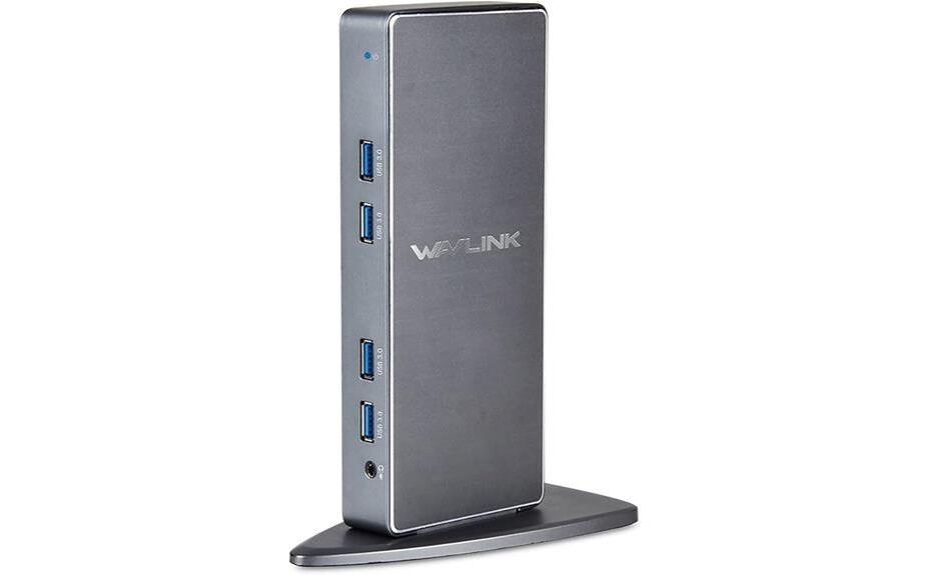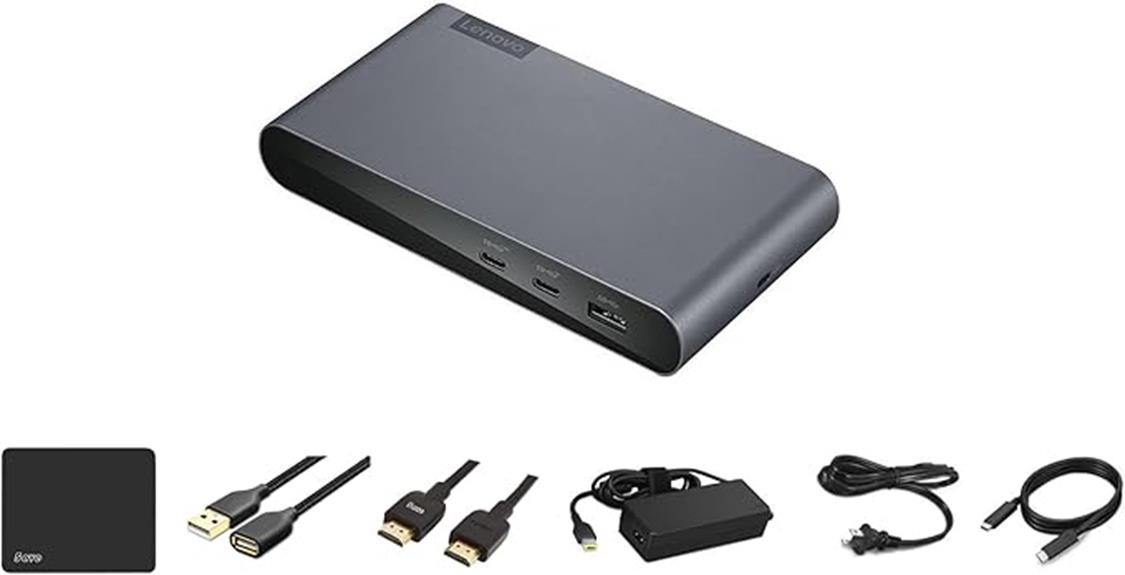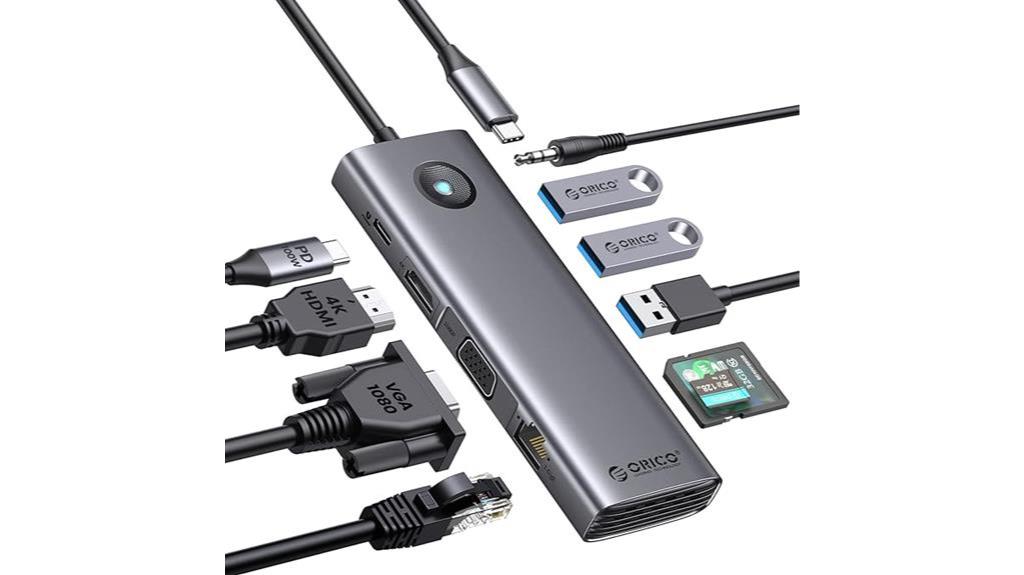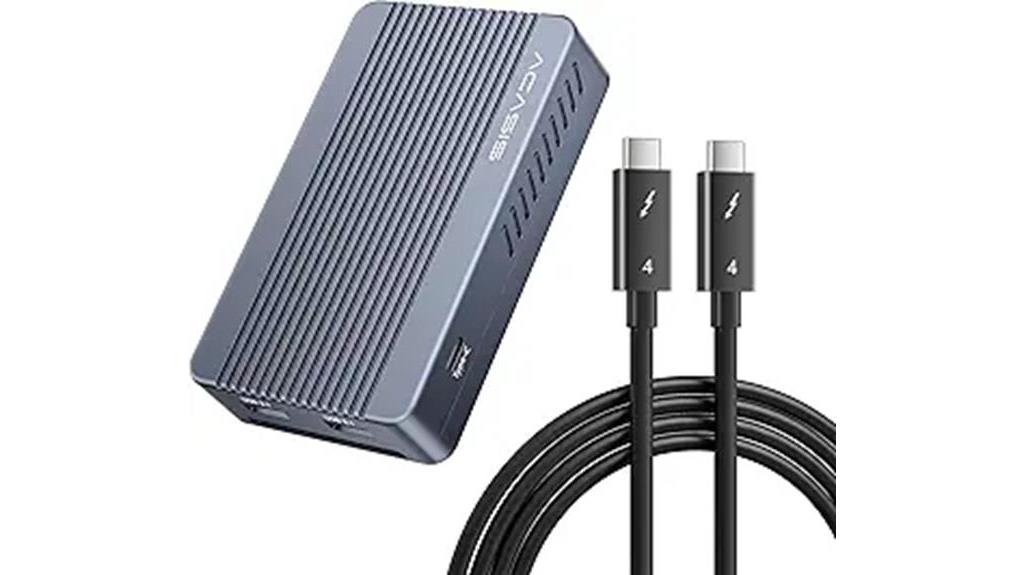


I've found the WAVLINK USB 3.0 Docking Station to be a solid choice for enhancing productivity. Its plug-and-play setup is straightforward, but I did face some installation challenges on MacOS due to driver compatibility. The docking station supports dual monitors and offers six USB 3.0 ports, making it ideal for multitasking. However, I noticed some flickering issues and limited performance for gaming. Overall, the build quality is impressive, and it's reasonably priced for what it offers. If you're considering a versatile docking solution, there's more to uncover about its capabilities and user experiences.
Key Takeaways
- The WAVLINK USB 3.0 Docking Station features robust metal construction, enhancing durability and reliability for daily use.
- It supports dual monitor configurations with high resolutions up to 2560×1440, ideal for multitasking and productivity.
- Installation may pose challenges, particularly with DisplayLink drivers and MacOS security prompts, impacting setup time.
- Users report occasional monitor flickering and USB peripheral compatibility issues, especially with certain devices on MacOS.
- Six USB 3.0 ports provide ample connectivity for various peripherals, streamlining workspace organization and data transfer.
When considering the WAVLINK USB 3.0 Docking Station, it is essential to recognize its versatile capabilities. My user experience varied considerably during the installation process. While I appreciated the plug-and-play feature, I encountered some installation challenges, particularly when downloading the DisplayLink drivers. On my Mac, I faced initial security prompts that required extra steps, which could be confusing for some users. Additionally, I had to grant permissions in my security settings, adding to the setup time. Though I successfully connected multiple peripherals, I noticed some incompatibility issues with certain USB devices. Overall, while the docking station offers great functionality, potential users should prepare for these installation challenges to guarantee a smooth setup experience.
Features and Benefits
The WAVLINK USB 3.0 Docking Station offers several standout features that enhance usability. With a built-in DisplayLink USB 3.0 GPU and six USB 3.0 ports, I can easily connect multiple devices and peripherals. Plus, the included DVI to VGA converter and hot-swapping monitor support make it convenient to set up dual displays without hassle.
Built-in DisplayLink USB 3.0 GPU
How does the built-in DisplayLink USB 3.0 GPU enhance the WAVLINK docking station's capabilities? The DisplayLink GPU offers several advantages, such as supporting dual monitor setups and high resolutions up to 2560×1440, which is great for multitasking. I appreciate how it enables seamless connectivity with various peripherals through its six USB 3.0 ports and Gigabit Ethernet. However, there are some performance limitations to contemplate. While it excels in productivity applications, it's not suitable for gaming due to potential lag and flickering issues. Additionally, users may encounter driver compatibility challenges, particularly on MacOS, which could affect overall functionality. Nonetheless, the DisplayLink GPU remains a solid choice for those seeking enhanced productivity in a versatile docking station.
DVI to VGA Converter Included
Versatility is a key feature of the WAVLINK USB 3.0 Docking Station, particularly with the inclusion of a DVI to VGA converter. This converter allows me to enjoy the DVI advantages, such as higher resolutions and increased bandwidth, while maintaining compatibility with older VGA monitors. It's a practical solution for those who still rely on VGA technology, enabling seamless integration of newer devices with legacy displays. I appreciate that I can easily connect my equipment without needing to invest in new monitors. This feature enhances productivity, especially in multi-monitor setups. Overall, the DVI to VGA converter adds significant value, ensuring broader compatibility and flexibility for various workstation configurations.
Six USB 3.0 Ports
Having six USB 3.0 ports on the WAVLINK USB 3.0 Docking Station greatly enhances my connectivity options. This abundance of ports allows me to connect multiple devices simultaneously, improving my overall productivity. With efficient USB bandwidth management, I can transfer data at high speeds, making it ideal for external drives and peripherals. However, I've faced some peripheral compatibility challenges, especially when connecting certain devices that require specific drivers. Despite this, the flexibility of having multiple USB ports makes it easy to adapt to various setups. Whether I'm using a mouse, keyboard, or external storage, the WAVLINK docking station meets my needs effectively, streamlining my workspace without the hassle of constantly swapping connections.
Hot-Swapping Monitor Support
Enjoying the convenience of hot-swapping monitors with the WAVLINK USB 3.0 Docking Station has greatly improved my workflow. The hot swapping benefits allow me to effortlessly switch between multiple monitors without needing to reboot or disconnect devices. This feature is particularly useful when I need to present or collaborate, as I can quickly connect a different display. The docking station supports various monitor compatibility options, including HDMI, DVI, and VGA, accommodating my diverse setup. While I've experienced some minor issues with monitor flickering, the overall functionality has been reliable. It's clear that this docking station considerably streamlines my work process by providing seamless changes between displays, improving productivity and flexibility in my daily tasks.
Product Quality
How does the WAVLINK USB 3.0 Docking Station measure up regarding product quality? From my experience, the build quality stands out, featuring a robust metal construction that feels durable and reliable. This solid design contributes to overall user satisfaction, especially when connecting multiple peripherals. Many users have praised its functionality with external drives and monitors, although some report occasional driver compatibility issues. While I found it generally effective, some encountered flickering monitors or connection problems after initial use, which can be frustrating. The USB-C ports, while functional, don't match competitors in charging capability. Overall, despite minor drawbacks, the WAVLINK docking station offers a commendable level of quality for its price, appealing to users seeking a reliable multi-port solution.
What It's Used For
I find the WAVLINK USB 3.0 Docking Station particularly useful for enhancing productivity with multi-monitor setups. It offers various peripheral connectivity options that streamline my workspace organization. This versatility makes it a valuable tool for anyone looking to maximize their efficiency while working.
Multi-Monitor Productivity Boost
Is there a better way to enhance productivity than utilizing multiple monitors? I've found that using the WAVLINK USB 3.0 Docking Station greatly boosts my multi-tasking efficiency. With the ability to connect two monitors simultaneously, I can effortlessly switch between tasks, keeping my workflow smooth and uninterrupted. This setup provides incredible workspace flexibility, allowing me to customize my screen layout to suit my needs. I can have documents open on one screen while researching on another, which saves time and reduces the frustration of toggling between windows. Overall, the WAVLINK docking station transforms my workspace into a highly efficient environment, making it easier to manage multiple projects and tasks effectively.
Peripheral Connectivity Options
In addition to enhancing multi-monitor setups, the WAVLINK USB 3.0 Docking Station excels in peripheral connectivity, making it a versatile choice for various devices. With six USB 3.0 ports, it offers ample peripheral compatibility for external drives, keyboards, and mice. This docking station's ability to integrate multiple devices simplifies my workspace, allowing me to connect everything I need without hassle. Whether I'm using it for productivity tasks or transferring data, the seamless device integration is a significant advantage. However, I've noted some users report driver compatibility issues, particularly with MacOS, which can affect performance. Overall, the WAVLINK docking station stands out for its capability to support various peripherals efficiently, enhancing my overall computing experience.
Enhanced Workspace Organization
With its capacity for multi-device connectivity and streamlined design, the WAVLINK USB 3.0 Docking Station greatly enhances workspace organization. I've found that this docking station considerably boosts my workspace efficiency by consolidating multiple connections into one hub. The six USB 3.0 ports allow me to connect various peripherals without cluttering my desk, while the dual monitor support keeps my workflow organized and visually clear. I can easily switch between tasks and applications, using my monitors as effective organizational tools. Additionally, the device's compact size guarantees it doesn't take up much space, contributing to a tidier environment. Overall, it's an invaluable asset for anyone looking to optimize their workspace and improve productivity.
Product Specifications
When considering the WAVLINK USB 3.0 Docking Station, it is essential to examine its specifications to understand its capabilities. Its performance benchmarks highlight its suitability for dual monitor setups, while certain compatibility issues may arise with various operating systems.
| Feature | Specification |
|---|---|
| Supported Resolutions | HDMI: 2560×1440@50Hz; DVI/HDMI: 1920×1200@60Hz |
| Ports | 6 x USB 3.0, Gigabit Ethernet, Audio |
| Compatibility | Windows (7-11), MacOS (10.14+), Ubuntu, ChromeOS |
The WAVLINK Docking Station is designed for versatile use, but potential users should be mindful of its limitations, especially concerning driver support and performance with gaming applications.
Who Needs This
Whether you're a professional needing to expand your workspace or a student seeking to streamline your setup, the WAVLINK USB 3.0 Docking Station offers practical solutions. If you're engaged in remote work, this docking station can greatly boost your productivity by allowing multiple monitor setups and connecting various peripherals effortlessly. It's perfect for anyone who regularly juggles tasks, needing easy access to additional screens or devices. The built-in USB 3.0 ports guarantee fast data transfer, making it an excellent choice for those who rely on productivity tools for their daily tasks. Ultimately, if you want to enhance your workspace efficiency and improve your workflow, the WAVLINK USB 3.0 Docking Station is worth considering.
Pros
The WAVLINK USB 3.0 Docking Station boasts several advantages that can greatly enhance a user's workflow. Based on user feedback and performance comparisons, I've noticed several key benefits:
- Versatile Connectivity: With multiple USB 3.0 ports and dual video outputs, it accommodates various peripherals effortlessly. Additionally, it supports a wide range of devices, ensuring seamless connectivity with PCs, MacBooks, and Chromebooks, and offering compatibility with peripherals like keyboards, mice, and webcams.
- High Resolution Support: It handles resolutions up to 2560×1440, making it ideal for productivity tasks across multiple monitors.
- Plug and Play: The easy installation process via Windows Update simplifies setup, particularly for users who prefer a hassle-free experience.
- Solid Build Quality: The metal construction adds durability, ensuring that the docking station stands up to daily use
Cons
While the WAVLINK USB 3.0 Docking Station offers notable advantages, it also comes with some drawbacks that users should consider. Here are a few key cons:
- Driver compatibility issues, especially with MacOS updates, can lead to frustrating experiences.
- Some users have reported monitor flickering and connection problems after initial setup.
- The USB-C charging ports are less effective compared to competitors, limiting charging options.
- It's not suitable for gaming, as performance can be inconsistent with high-demand applications.
These factors are essential to keep in mind, particularly if you rely heavily on driver support or intend to use the docking station for resource-intensive tasks.
What Customers Are Saying
Many customers have shared their experiences with the WAVLINK USB 3.0 Docking Station, highlighting both positive aspects and challenges. In various customer testimonials, users praised the build quality and efficient setup for dual monitors on Windows devices. However, user frustrations arose primarily from compatibility issues, especially on MacOS, where some reported flickering and connection problems. Several users also noted difficulties with USB peripherals, including wireless mouse adapters, and mentioned that the USB-C ports weren't as effective for charging compared to other docking stations. While many appreciated its functionality for productivity tasks, the inconsistent performance across different operating systems left some potential buyers hesitant, particularly those using Apple products.
Overall Value
When considering the overall value of the WAVLINK USB 3.0 Docking Station, it's important to weigh its features against potential limitations. The docking station offers solid functionality with multiple ports and dual video outputs, which I find appealing for productivity setups. In a price comparison with similar products, it generally falls within a reasonable range, especially given the build quality. However, user feedback highlights some issues, particularly with driver compatibility on MacOS and inconsistent performance. While it excels for Windows users, those with Apple devices might face challenges. Overall, I believe the value is high for those needing a versatile docking solution, but potential buyers should carefully consider compatibility before purchasing.
Tips and Tricks For Best Results
To achieve the best results with the WAVLINK USB 3.0 Docking Station, I often recommend starting with a clean installation of the DisplayLink drivers. This means uninstalling any previous versions before downloading the latest drivers from the official DisplayLink website. It's essential to follow the installation tips provided, especially on MacOS, where security settings may require adjustments. Regular driver updates can also greatly improve performance and compatibility, so I make it a habit to check for updates periodically. If you encounter issues, try power cycling the docking station or hot-swapping monitors. Finally, verify your USB drivers are updated, particularly for Windows 7, to avoid connectivity problems with peripherals.
Conclusion
After implementing the tips and tricks for ideal use, it's clear that the WAVLINK USB 3.0 Docking Station presents a solid option for users seeking to enhance their productivity. While many user experiences highlight its build quality and functionality, some installation challenges can arise, particularly with driver compatibility on MacOS. I found that granting necessary permissions during installation is essential for a seamless setup. Although it's not suitable for gaming, the docking station excels in providing dual monitor support for productivity tasks. Users should remain aware of potential performance inconsistencies across different operating systems. Overall, despite a few drawbacks, the WAVLINK USB 3.0 Docking Station offers great value for those who prioritize versatility in their workspace.
Frequently Asked Questions
Is the WAVLINK Docking Station Compatible With Linux Systems?
When I tried connecting the docking station to my Linux system, it felt like opening a book with missing pages. While it supports Linux, I faced compatibility issues with drivers that made setup challenging.
Can I Use This Docking Station With a Chromebook?
I've found that while this docking station offers decent Chromebook connectivity, USB compatibility can be inconsistent. It's worth checking DisplayLink support for specific Chromebook models to guarantee it meets your needs effectively.
What Is the Warranty Period for the WAVLINK Docking Station?
The warranty coverage for the docking station is 12 months. In my user experience, this period offers decent protection, but I'd recommend checking the specifics to guarantee it meets your needs before purchasing.
Does It Support Audio Output Through Hdmi?
When I set up my home office, I discovered the docking station supports audio output through HDMI. The audio quality was impressive, highlighting its HDMI compatibility, perfect for video calls and streaming my favorite shows.
Are Firmware Updates Available for This Docking Station?
I've found that firmware updates are indeed available for this docking station. These updates enhance performance and compatibility. The update process typically involves downloading the latest drivers from the manufacturer's website, ensuring ideal functionality.
Disclosure: As an Amazon Associate, I earn from qualifying purchases.



